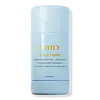What's inside
What's inside
 Key Ingredients
Key Ingredients

 Benefits
Benefits

 Concerns
Concerns

 Ingredients Side-by-side
Ingredients Side-by-side

Caprylic/Capric Triglyceride
MaskingCocos Nucifera Oil
MaskingTapioca Starch
Stearyl Alcohol
EmollientMagnesium Hydroxide
AbsorbentParfum
MaskingHydrogenated Castor Oil
EmollientOryza Sativa Bran Wax
Skin ConditioningBehenyl Alcohol
EmollientPolyglyceryl-3 Stearate
EmulsifyingMandelic Acid
AntimicrobialXylityl Sesquicaprylate
AntimicrobialAnhydroxylitol
HumectantMangifera Indica Seed Butter
Skin ConditioningPlatonia Insignis Seed Butter
EmollientTocopherol
AntioxidantCaprylic/Capric Triglyceride, Cocos Nucifera Oil, Tapioca Starch, Stearyl Alcohol, Magnesium Hydroxide, Parfum, Hydrogenated Castor Oil, Oryza Sativa Bran Wax, Behenyl Alcohol, Polyglyceryl-3 Stearate, Mandelic Acid, Xylityl Sesquicaprylate, Anhydroxylitol, Mangifera Indica Seed Butter, Platonia Insignis Seed Butter, Tocopherol
Propylene Glycol
HumectantWater
Skin ConditioningPropanediol
SolventSodium Stearate
CleansingTapioca Starch
Glycerin
HumectantSaccharomyces Ferment Filtrate
HumectantDiatomaceous Earth
AbrasiveSilica
AbrasiveParfum
MaskingPolyglyceryl-10 Caprylate
EmulsifyingSorbitan Oleate Decylglucoside Crosspolymer
CleansingAloe Barbadensis Leaf Juice
Skin ConditioningHydrolyzed Jojoba Esters
Skin ConditioningNannochloropsis Oculata Extract
HumectantPanax Ginseng Root Extract
EmollientPropylene Glycol, Water, Propanediol, Sodium Stearate, Tapioca Starch, Glycerin, Saccharomyces Ferment Filtrate, Diatomaceous Earth, Silica, Parfum, Polyglyceryl-10 Caprylate, Sorbitan Oleate Decylglucoside Crosspolymer, Aloe Barbadensis Leaf Juice, Hydrolyzed Jojoba Esters, Nannochloropsis Oculata Extract, Panax Ginseng Root Extract
Ingredients Explained
These ingredients are found in both products.
Ingredients higher up in an ingredient list are typically present in a larger amount.
Parfum is a catch-all term for an ingredient or more that is used to give a scent to products.
Also called "fragrance", this ingredient can be a blend of hundreds of chemicals or plant oils. This means every product with "fragrance" or "parfum" in the ingredients list is a different mixture.
For instance, Habanolide is a proprietary trade name for a specific aroma chemical. When used as a fragrance ingredient in cosmetics, most aroma chemicals fall under the broad labeling category of “FRAGRANCE” or “PARFUM” according to EU and US regulations.
The term 'parfum' or 'fragrance' is not regulated in many countries. In many cases, it is up to the brand to define this term.
For instance, many brands choose to label themselves as "fragrance-free" because they are not using synthetic fragrances. However, their products may still contain ingredients such as essential oils that are considered a fragrance by INCI standards.
One example is Calendula flower extract. Calendula is an essential oil that still imparts a scent or 'fragrance'.
Depending on the blend, the ingredients in the mixture can cause allergies and sensitivities on the skin. Some ingredients that are known EU allergens include linalool and citronellol.
Parfum can also be used to mask or cover an unpleasant scent.
The bottom line is: not all fragrances/parfum/ingredients are created equally. If you are worried about fragrances, we recommend taking a closer look at an ingredient. And of course, we always recommend speaking with a professional.
Learn more about ParfumTapioca starch is a thickening agent and is made from the cassava root, also known as yucca.
According to a manufacturer, it is an excellent talc replacement.
It is gluten-free.
Learn more about Tapioca Starch